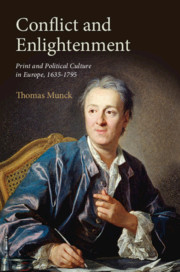Book contents
- Conflict and Enlightenment
- Conflict and Enlightenment
- Copyright page
- Contents
- Figures
- Acknowledgements
- Introduction
- 1 Print, Production, Authors and Readers
- 2 Instability and Politicisation (1630–77)
- 3 Subversive Print in the Early Enlightenment
- 4 Translation and Transmission across Cultural Borders
- 5 High Enlightenment, Political Texts and Reform 1748–89
- 6 Revolution: Democracy and Loyalism in Print 1789–95
- Conclusions
- Select Bibliography (Works Published after 1800)
- Index
4 - Translation and Transmission across Cultural Borders
Published online by Cambridge University Press: 21 October 2019
- Conflict and Enlightenment
- Conflict and Enlightenment
- Copyright page
- Contents
- Figures
- Acknowledgements
- Introduction
- 1 Print, Production, Authors and Readers
- 2 Instability and Politicisation (1630–77)
- 3 Subversive Print in the Early Enlightenment
- 4 Translation and Transmission across Cultural Borders
- 5 High Enlightenment, Political Texts and Reform 1748–89
- 6 Revolution: Democracy and Loyalism in Print 1789–95
- Conclusions
- Select Bibliography (Works Published after 1800)
- Index
Summary
Although French was displacing Latin as the international language of choice, print increasingly relied on the vernacular of its intended readers. This allows the translation and transnational dissemination of texts to be mapped more precisely. Printing itself helped to standardise 'national' languages, but authors and translators also learned to gauge their vocabulary and style of writing to suit a wider audience. Theories of language were combined with detailed study of core languages and dialects, leading to a greater awareness of the principles and practices of translation. Dictionaries and other language tools had first emerged in connection with Bible translation, but from the late seventeenth century more imaginative reference works and encyclopedias allowed authors to adopt more sophisticated writing techniques to evade censorship. For historians aware of these processes of international transmission, printed texts of all kinds provide a vast resource not just for content analysis, but also for conceptual history.
Keywords
- Type
- Chapter
- Information
- Conflict and EnlightenmentPrint and Political Culture in Europe, 1635–1795, pp. 180 - 224Publisher: Cambridge University PressPrint publication year: 2019



